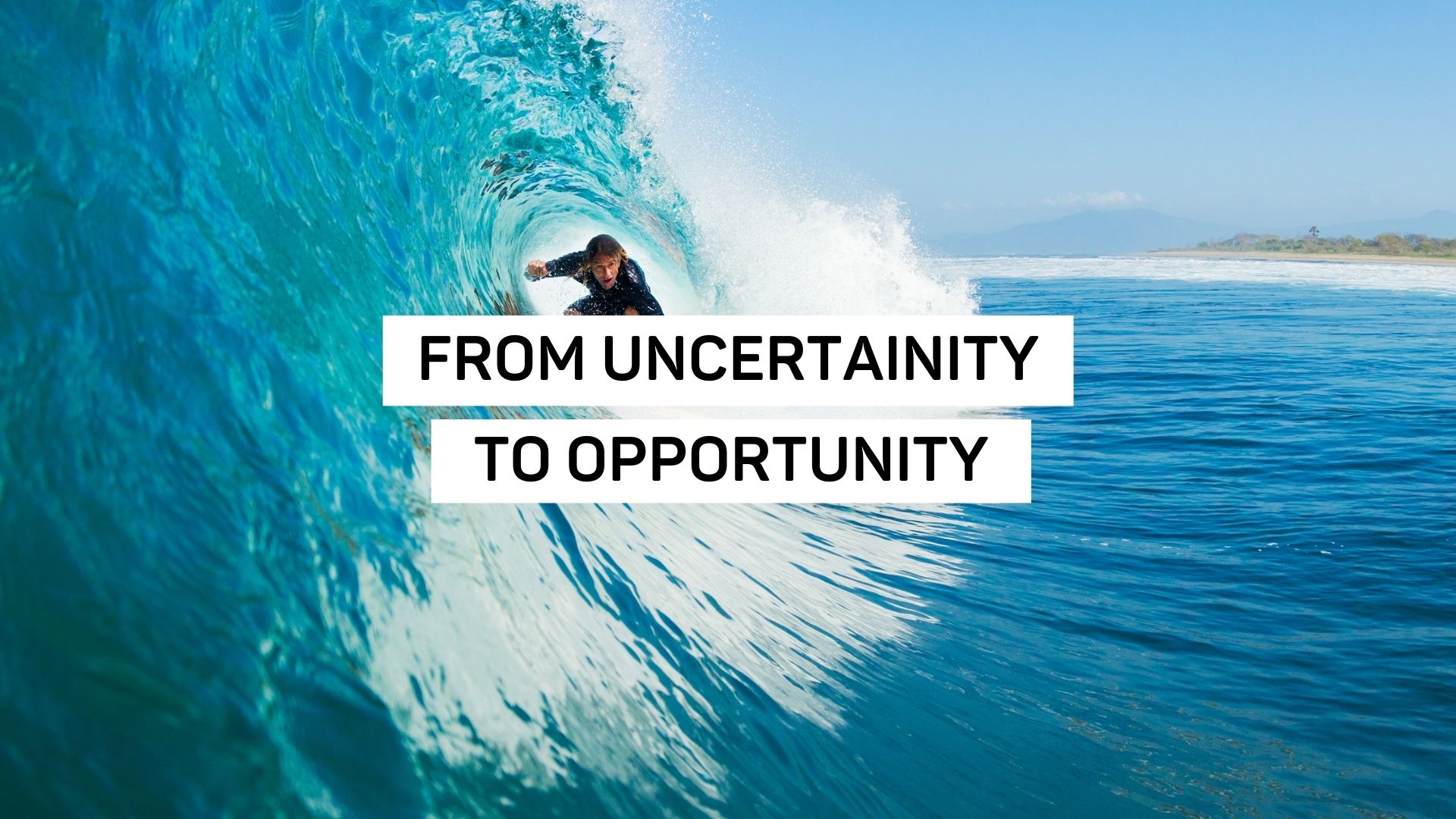
From Uncertainty to Opportunity
I recently helped a restaurant owner plan for an uncertain future. How can we apply this way of thinking? How do we identify actions that we have not thought about before? How do we know when to act? In short:
How do we transform uncertainty into opportunity?
I put together a small Do-It-Yourself guide and some worksheets we utilise in our MBA and Executive Education classes. The guide follows a four-step logic that is suitable for sole traders and leadership teams in small and medium sized enterprises.
STEP 1: Broaden your perspective on what is possible
When we want to reperceive our environment we first need to step out of existing corporate and industry mindsets.
Get started by setting an appropriate timeframe within which to explore what could have the highest impact on your business. A one-year timeframe is likely to be significantly different from a five-year one. For the restaurant owner, length and intensity of confinement measures would have in the short term the highest impact. However, over time, the spending power of customers, reliability of the supply chain and customer attitudes towards eating out may become pertinent uncertainties.
The aim is not ‘get it right’, but to think outside the box. One way to stimulate this is to think about which factors drive uncertainty in your business. With your team, explore:
- What might a best-case scenario for my business look like?
- What might a worst-case scenario for my business look like?
Imagine yourself operating in these situations. What factors could have led to these occurring? You might use these 11 sources of disruption as a starting point. Then, prioritize these in terms of strongest impact on your business.
In the restaurant case, there were two factors: intensity of confinement (takeaway only versus all operations banned) and length of confinement (1-2 weeks versus several months). For each of these, the two extreme but plausible outcomes were identified and plotted on a scenario cross as shown in Step 1 below.
It is also fine to take extreme future projections and build a scenario around it which describes how the market works, what it means for customers, and who the most important stakeholders are. In the case of a restaurant, this could include:
- Restaurants not allowed to open
- Cooked meals only available through take away
- Food and vegetable box deliveries allowed
- Digital services such as online tutorials, bespoke meal plans
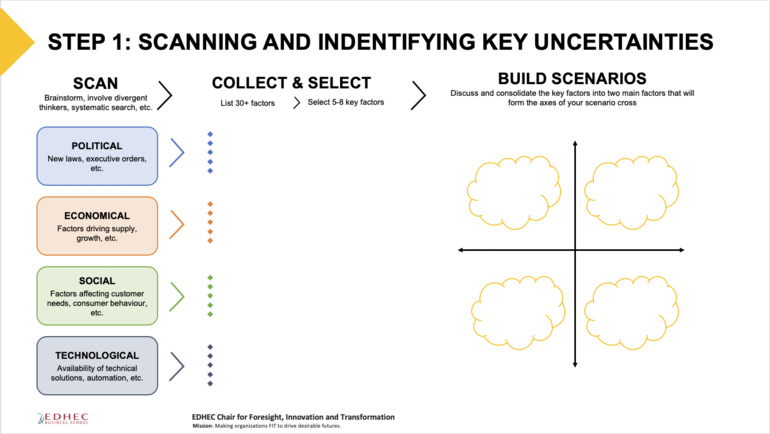
At this stage, it is important to “walk in the future”. Describe as vividly as you can what this future would look like. You can divide your team into smaller groups to explore:
- How did this scenario develop?
- What were key influencing factors?
- What are key turning points?
This will provide you with a shared picture of the future which is rich in detail, broadens your perspective on what is possible, and highlighted signals about futures you would not have anticipated before.
STEP 2: Map your strategic choices
It is all too easy for your view on strategic choices to be influenced by what has made you successful in the past. This is reliable in a stable environment. In unstable, unpredictable environments, being able to act on options in alternative outcomes is useful.
To explore alternatives we use a Strategy Playbox. Start with defining strategic action fields, which represent key aspects within your control and the range of possible alternatives for your business. In the restaurant case, the action fields and related alternatives were:
- Location: Keep open, kitchen only, temporary close, permanent close
- Employees: Keep 100% of staff employed, Keep 50% of staff employed, Keep kitchen staff and train others to deliver, close
- Marketing: Local mouth-to-mouth, flyer and digital, digital only, none
- Offering: Dine in and take away, dine in only, take away only, close
As a sense check, each action field should contain an alternative that captures a choice you have already made. For example, the restaurant had already chosen to stay open, keep all staff employed, rely on mouth-to-mouth marketing and focus on dine-in customers.
This further helps you to systematically map all the other choices (e.g. close dine-in, add kitchen space, build up online marketing, focus on cooked food delivery, deliver vegetable and meat boxes, etc).
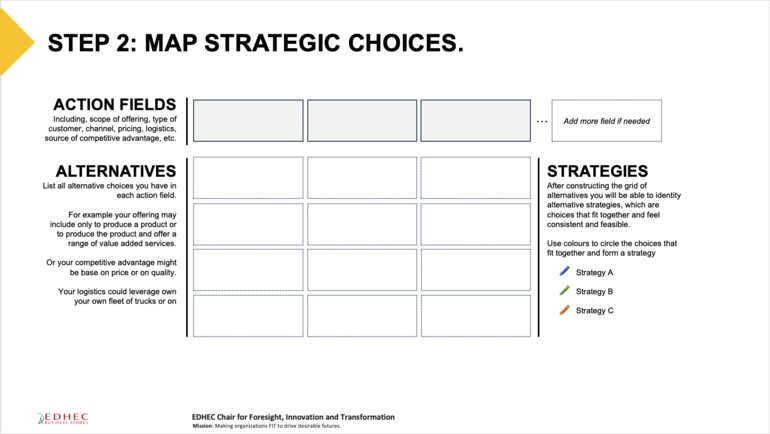
STEP 3: Craft alternative strategies
Using the same grid that you have developed in step 2, you can identify alternative strategies that are consistent. In this step you often discover strategies from known rivals, that are similar to you, and also strategies of new rivals, that might be digital companies, that enter your industry with very different approaches, leveraging on network effects and platform with which they seek to control the market. You can use colors to visualize the alternative choices.
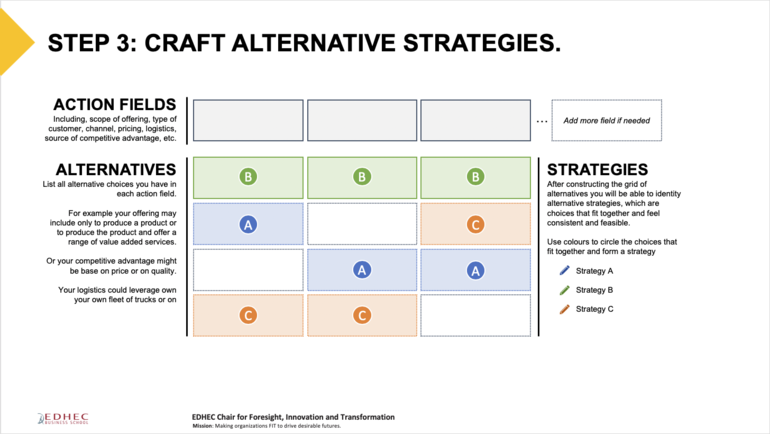
For example, in the restaurant case, the Go Digital strategy was a combination of Kitchen only (location action field), Keep kitchen staff and train others to deliver (employees action field), Flyer and digital (marketing action field), Close (offering action field).
Step 2-3 have hopefully helped you to radically open your perspective on alternative strategies. It is key that you fight the instinct to check feasibility too early. The mindset is that true strategy is only limited by your imagination. Resource constraints only limit tactics. In strategy, missing resources and capabilities can be accessed through partnerships, built, or acquired!
Step 4: Decide on what to do next
Finding new winning strategies under uncertainty is above all a creative process. In this creative process you should engage also your stakeholders, thought leaders you know, and discuss early ideas with your colleagues across your organization.
Under uncertainty, it is not wise to break down an overall goal into actions, as the goal and associated actions will be subject to change. Instead, you identify three different types of actions:
- No regret moves: Yields benefits in all scenarios
- Options: Develop a way to play in a market which is interesting but not certain to develop
- Big bets: True entrepreneurial decisions, where you trust your insights into future markets, that you are ready to bet your organization on
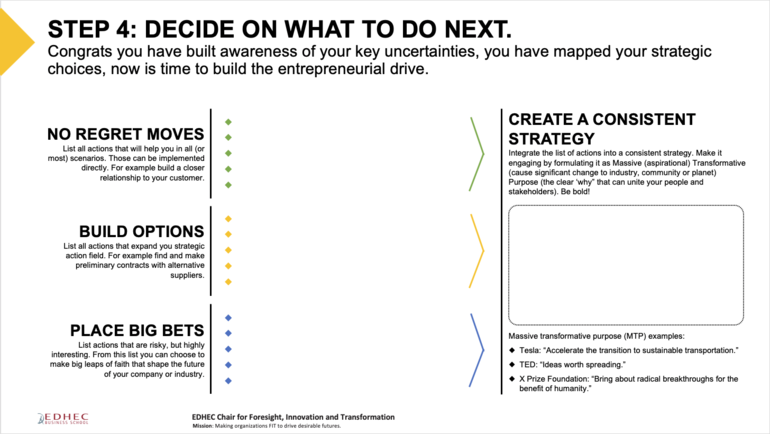
Integrating these actions allows you to formulate a consistent strategy that simultaneously acknowledges the uncertainty in the environment and provides a clear set of options to pursue over time. Ultimately, what is feasible for you will depend on the metrics by which you measure success, which in turn is linked to what your organization values most.
There is no guarantee that following this process will lead to success. The length of the leap that you will be able to make will depend on:
- Ability to reperceive: How well have you managed to integrate your teams and stakeholders in the scanning process
- Ability to see systemic change: How well you developed and leverage on the scenarios and alternative strategies, working with your colleagues across the organization and your stakeholders
- Ability to mobilize: Creating a purpose that matters for your organization, its members, as well as the community and maybe even the planet.
I hope that this little Do-It-Yourself guide will prove useful for you and would love to hear about your experiences. Maybe you can even share here as comments some tips for all the others who will in the next weeks have to turn the COVID-19-induced uncertainty into opportunity, for them, their communities, and the planet.
Further reading
Courtney, H., Kirkland, J., & Viguerie, P. (1997). Strategy Under Uncertainty. Harvard Business Review, 1997(11), 67–79. https://hbr.org/1997/11/strategy-under-uncertainty
Lehr, T., Lorenz, U., Willert, M., & Rohrbeck, R. (2017). Scenario-based strategizing: Advancing the applicability in strategists’ teams. Technological Forecasting and Social Change, 124, 214–224. https://doi.org/10.1016/j.techfore.2017.06.026
Tighe, S. (2019). Rethinking Strategy: How to Anticipate the Future, Slow Down Change, and Improve Decision Making. Wiley.
Article originally published on March 25th 2020 on LinkedIn
